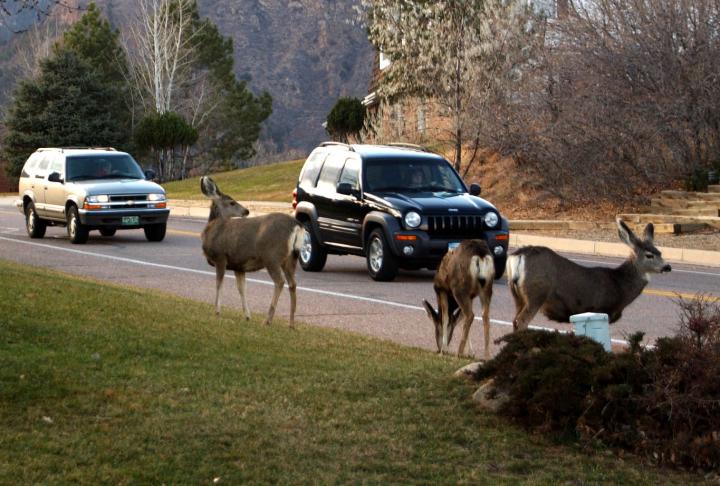
Credit: Colorado Parks and Wildlife
A new study from Colorado Parks and Wildlife (CPW), WCS (Wildlife Conservation Society) and Colorado State University (CSU) shows that dramatic increases in residential and energy development is associated with declining early winter recruitment in western Colorado's mule deer populations.
The study goes beyond existing research that to date has focused on single populations or short-term effects of human land use, such as changes in animal behavior and habitat use patterns, and instead is the first to correlate land-use change over 30 years to long-term trends in 44 mule deer populations across western Colorado.
"There's a lot of research showing that deer and other wildlife avoid human development, and we've expected that such changes in behavior may influence populations," said lead author and Wildlife Researcher Heather Johnson from CPW. "While wildlife managers have suspected that these relationships exist, this study is really the first to quantify the association between expanding development and declining deer recruitment across western Colorado."
Mule deer are an icon and fixture of the American West and serve as an indicator of ecosystem health. In addition, they provide significant hunting opportunity and revenue to Colorado and other states that is used for wildlife management and conservation.
In their study, the scientists looked at data on residential and energy development across western Colorado from 1980 to 2010. During this period, Colorado's human population nearly doubled, adding 2.2 million people, while more than 3,800 square miles of deer habitat was converted to residential housing, and more than 20,000 new oil and gas wells were drilled across the study area. Additionally, annual variation in weather conditions, which are known to influence deer populations, were considered over the same period.
Quantifying the changes in land use, the scientists correlated impacts to habitat with early winter mule deer recruitment, or the number of fawns per adult female deer observed during December and January helicopter surveys. They found that increasing residential and energy development within deer habitat was correlated with declining recruitment rates-particularly in lower elevation winter seasonal ranges, where deer migrate to avoid severe weather.
"In many places in Colorado, biologists have watched deer ranges get encroached by new homes, roads, and gas and oil wells, at the same time as deer numbers have declined. It looks like these impacts to habitat may be having a greater effect on deer populations than we've previously recognized," said Johnson. What's more, while energy development had a similar degree of effect as key weather variables, residential housing had more than twice the magnitude of effect of any factor investigated.
"Very little research has been conducted on the effects of residential development on large herbivore populations, but in our study, residential development was the factor most strongly correlated with declining recruitment," said Associate Conservation Scientist Sarah Reed of WCS. "The challenge is that residential development typically occurs on private property, where there is limited opportunity to protect wildlife habitat."
Scientists remain uncertain about the specific factors that may be responsible for declining recruitment, but suspect that loss and fragmentation of habitat by infrastructure and roads, entanglement in fences, disturbances by people, increased vehicle traffic, and domestic animals all likely contribute to the problem.
Reed said, "When we see deer in town or browsing in our front yards, we tend to think that both human and deer populations are thriving–but now we know this is not necessarily the case. People often move to rural areas because they love the outdoors and want to experience nature, but the expansion of rural homes and ranchettes across Colorado looks to be having detrimental impacts on deer populations."
Researchers emphasize that their results do not demonstrate a causal relationship, as analyses relied on long-term observational data, and that the factors affecting mule deer recruitment are multifaceted. Annual recruitment is likely driven by the cumulative effects of land-use change and several other factors that were outside the scope of the study, such as forage conditions, disease, competition with elk, and predation.
The authors stated that their findings suggest that "further increases in development on deer ranges are not compatible with the goal of maintaining highly productive populations." They recommend that local governments, land management agencies and wildlife managers will need to work closely to reduce the impacts of future development on mule deer habitat, especially on sensitive winter ranges. CPW hopes to use results from the study together with its recent West Slope Mule Deer Strategy to prioritize deer ranges for conservation that are particularly vulnerable to future development, and to improve collaborative efforts to enhance mule deer populations and their habitat.
"Increases in Residential and Energy Development are Associated with Reductions in Recruitment for a Large Ungulate," appears currently in Global Change Biology Authors include: Heather E. Johnson, A. Andrew Holland, Eric J. Bergman, Trevor Balzer and James Garner of CPW; and Jessica R. Sushinsky and Sarah E. Reed of WCS and CSU.
###
Media Contact
Scott Smith
[email protected]
718-220-3698
@TheWCS
http://www.wcs.org




